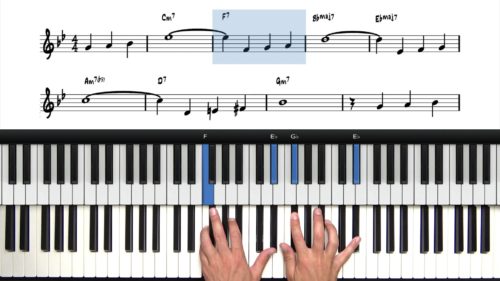Corcovado Solo Piano Tutorial
The first jazz standard lesson in this course is "Corcovado" written by the great Antonio Carlos Jobim and lyrics by Vinicius de Moraes.
"Corcovado" is the name of the mountain in Rio de Janiero with the statue of Christ on top. The statue sits so high above the city that you can see it from all around. One of the lyrics reads: "you can see the Corcovado from the window of a very quiet place".
The Original Chords Played By Jobim
If you look through the RealBooks you will find many different sets of changes. The chords that we will be using for this arrangement are the original changes played by Jobim himself.
The melody is often interpreted by the performer, and you have the creative freedom to phrase the melody as you like.
Inner Voice Movement
There are subtle inner voices within the harmony that can be easily missed. We touch upon these voices in this lesson and demonstrate how to accentuate them in your voicings.
The next lesson in this course is a detailed study of inner voice movement over this tune.
Practice Tips
-
It's a good exercise to listen to many different vocal versions, and emulate the phrasing of singers.
-
Pay attention to the subtle inner voices moving within the chord changes.
- Moving from the minor 7th to minor 6th is a beautiful inner voice to accentuate throughout the form.








Jovino – this is a wonderful breakdown of the song and its complex chords. With the internal voicings, you really give a sense of the logic of Jobim’s harmony.
A lot of the voicings here are great but I don’t believe are taught in any of the voicings tutorials elsewhere on the site – e.g. playing:
C9sus4 as C (bass) + G-Bb-D-F (i.e. Gm7 first inv.)
Gm7 as G (bass) – + F-A-Bb-D (i.e. Bbmaj7 first inv.)
Fmaj7 as F (bass) + E-G-A-D (i.e. Cmaj9)
I’m happy to add them to my repertoire thought! (Of course if you play 2 notes in LH + 3 in RH they look different.)
The trick then becomes how to memorize a bunch of formulas (spells?!) for finding a given chord or voicing quickly: one I often use for an easy-to-play variant of Herbie Hancock’s m11 chord is, for example:
Am11
LH: E-A-C (Am triad, second inv.)
RH: D-G-B (G major triad, second inv.)
It would be useful to have a tutorial explaining some rules of thumb for voicings in Jobim songs, especially all the altered harmonies – b5, b9, b13, #5, #11, etc., which get me bogged down in songs like Desafinado, Triste, or Viva Sonhando. There are lots of glimpses of these voicings scattered throughout the tutorial, but any pointers on how to construct them would be really useful. Many thanks in any event for an inspiring tutorial!
Looking forward to the Wave tutorial – it was my first encounter with Jobim so am excited to tackle it properly at last!
Hey Martin!
Thanks for this brilliant lesson summary and voicing analysis.
Great suggestion with the “rules of thumb” for voicings in Jobim songs… I will pass all your feedback onto Jovino.
“Desafinado” is being covered in Jovino’s next course which we are recording very shortly. You can see the full list of topics here: pianogroove.com/community/t/new-course-by-jovino-ideas-needed-please-for-next-course/1784/21
Enjoy the other lessons in this course, and more to come very soon!
Cheers,
Hayden
Sounds great – thanks Hayden!